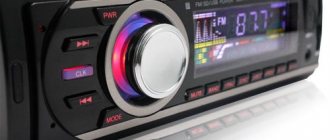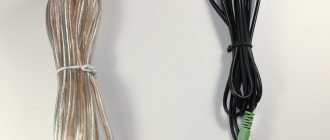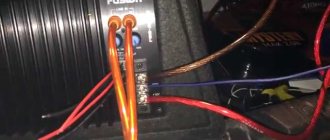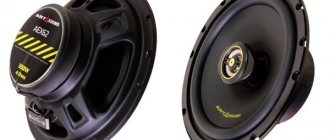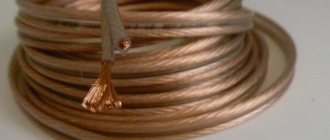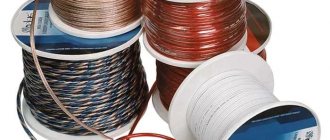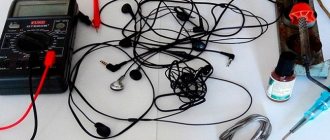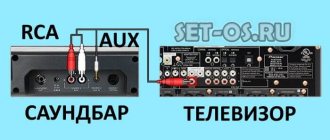Not only the sound quality, but also the reliability of the entire sound system depends on the choice of wires and connection of the speakers in the car. It is important to know which wire to use for the speakers. Any car audio system consists of several components. Depending on the level of difficulty, their number may vary. There must be a signal source, power amplifier and speakers. There may be several of them. These are front speakers, side speakers on car doors, rear speakers on the trunk lid and a subwoofer.
The opinion that it is enough to purchase high-quality sound equipment and your car will have great sound is wrong. Many people do not attach much importance to connecting cables for audio equipment, although they are ultimately responsible for the quality of sound reproduction.
Wires for car speakers
Wires for car audio speakers are selected according to several parameters. This is the conductor material, insulation type and cross-section. Speaker cables are made from several types of materials:
In terms of the quality of transmission of an alternating audio frequency signal, a connecting cable made of pure silver is the undisputed leader. It has minimal resistance, does not oxidize and does not introduce significant distortion. It is rarely used in cars due to its high price. Cables made of copper coated with a thin layer of silver give good sound, with a slight increase in high frequencies. Pure oxygen-free copper is the main material for connecting cables to speaker systems. These wires are used most often. Wires for connecting aluminum speakers have higher resistance, which affects the quality of signal transmission. In addition, aluminum oxidizes faster and is more brittle, which can make it difficult to install inside the car. Copper-coated aluminum cables are somewhat better in quality, but in any case worse than copper wires.
Wire for speakers in column
An important part of getting high-quality sound is connecting cables to the amplifier and speakers. The speaker wire in your car can be connected in several ways. Typically, a wire clamp under a washer and nut is used, or ready-made cables with RCA or “tulip” connectors are used. Often the stripped wire is pressed into a flat petal-type contact. When clamping a stripped wire, it must be thoroughly tinned so that the copper at the junction does not oxidize. The use of ready-made cables is complicated by the fact that they are produced at a certain length and it can be difficult to route the cables as needed for the configuration of the sound system.
Every car enthusiast who values high-quality sound should know the basics of installing an audio system. Today, not all cars are equipped with radios, so drivers have to install the speakers themselves. How to connect speakers to a car radio, how to position the speakers correctly and what you need to know about wire insulation - read below.
Which wires are best to use for car speakers?
Most car enthusiasts do not know what wires are needed for speakers, although the principle of choice is quite simple. All cables that are used in a car to connect audio equipment are divided into three groups:
Power cables are designed to supply power from the car battery to the amplifier, since the music center is already connected by standard cabling. In order to determine the cross-section of the power wire, it is enough to calculate the total power of the sound system and divide this value by the voltage of the vehicle's on-board network in accordance with the formula I=P/U. The result is the current consumed.
For an amplifier with 4 channels of 40 watts each, this value will be equal to 24 amperes. 40*4*2=24. You need to multiply by two, since 40 watts is the rated power. Next, you need to take into account the distance from the battery to the amplifier. With a cable length of 3-4 meters, its cross-section should be at least 8.0 mm2. Interconnect cables come in two types. This is a twisted pair wire or coaxial cable with a central core and metal braid. The best results will be obtained using double-shielded copper coaxial cable. Very important elements of the sound system are the wires running from the amplifier to the speakers.
Elsheep-Team
Wiring for audio system. Answers to frequently asked questions. Correcting common mistakes.
1. the reason for writing this article 2. widespread errors 3. power and acoustic wiring standards. 4. wiring “regular” or “for competitions”. What to choose? 5. cable manufacturers. What to buy? 6. power wiring. 7. acoustic wiring. 8. interconnect cables. How to route? Which manufacturer to choose? 9. Wiring consumables. 10. batteries, generators, power distributors. 11. What should not be done when laying cables? 12. Recommended wiring sizes for common audio system circuits. 13. useful links
1. the reason for writing this article
The reason for writing this article was that I often have to deal with incorrect installation of audio systems in cars.
We will omit how the equipment itself is installed (amplifiers, acoustics, subwoofers, radios), and will dwell in detail on the “veins” and “nerves” of a modern car audio system - wires and cables. I would like to hope that after reading this article, a person who decides to install sound in a car with his own hands will not make standard mistakes and will do everything right.
2. widespread mistakes , let's list the main ones - incorrectly selected diameter of power wiring - incorrect switching of power and acoustic wiring - failure to comply with basic safety principles when laying cables - use of cheap wiring when installing expensive components (which negatively affects the final quality of the entire system) But most often Another thing happens - the wiring is simply “thrown” through the car interior to the required place (for example, to an amplifier), is not protected in any way, and is not secured in any way. These so-called “snots” not only spoil the entire appearance of the system, but can also lead to very disastrous consequences, for example, a short circuit, which can cause the car to burn out.
3. standards for power and acoustic wiring in the metric system (Russia), the concept most often used is “mm.kv” – i.e. square millimeter. In America, and throughout Europe, they use markings in Gages (American Wire Gauge / abbreviated AWG)
Below is a size chart
PS in extreme audio systems, a cable of size 0 AWG, the so-called “null”, is sometimes used. This is a 53 mm2 cable. used mainly in systems designed for SPL (Sound Pressure Level) competitions
4. wiring “regular” or “for competitions”. What to choose? When creating a system, you need to clearly understand why this system is being built.
If you are installing an audio system for everyday use, then there is no point in laying the cables in such a way as required by the regulations of car audio competitions. Of course, this is preferred, but not required. Professional installers usually use some “competition” best practices when installing conventional systems, but this rather indicates the quality of the studio itself and the professionalism of the installers. These, for example, include fastening the power wire along its entire length every 20 cm. Laying all the wiring in a corrugated tube, etc.
To participate in competitions, there are clearly developed regulations for all types of wiring in the car (power, acoustic, interconnect cables). If you do not follow these regulations, then when judging the quality of the installation, the participant will be awarded penalty points, which can lead to defeat in the competition.
You need to understand that “regular” and “competition” wiring are completely different things in terms of installation. The same wires can be used as the basis.
In this regard, you also need to understand that if you want to do wiring in your car according to competition regulations, you will need to spend additional money. The more complex the wiring, the more money you will pay to install it.
The brand of cables also affects the cost. This is covered in the next chapter.
5. cable manufacturers. What to buy? Today in Moscow you can buy wires and cables from many producing countries. The basis of the caraudio market, of course, is products from China and Korea. Almost any budget cable you can find in a store is made in China. Everything here is the same as in any other area related to household appliances or equipment for humans.
There are also several Russian brands that order production under their brands in China. The quality of their products is very high, which is reflected in the price. There are good cables made in Germany, but you won’t find them widely sold. They are used mainly in car audio studios. In expensive projects.
There are cables designed for home audio. It happens that such cables are also used in automotive systems. But this approach has disadvantages. However, wiring specifically designed for operation in difficult vehicle conditions is strikingly different in its performance characteristics from wiring for the home. This also applies to the characteristics of the insulating layer and the conductivity characteristics of the cable.
When choosing cables, you need to rely on objective need. If you have a limited budget, then you should not consider buying an speaker cable that costs 1,500 rubles. per linear meter. A cable from a good manufacturer, made in China, will do just fine at a price of 150-200 rubles per meter.
I do not recommend buying ready-made installation kits. Typically, such kits are designed for installation of 2 or 4 channel amplifiers. Their cost ranges from 1000 rubles. and higher. At this price it is impossible to fit cables and consumables of good quality. I recommend that you select all system components separately. It will be more expensive, but much better quality.
If you still want to install an amplifier with little expense, then take a closer look at the kits from famous manufacturers Stinger and DAXX. They are of quite good quality.
You can give a general rule that installers use: The price of consumables for a specific installation is 10% of the cost of all equipment.
Brands that can be recommended for purchase: Stinger, Chernov Audio, DAXX, Monster Cable, Phoenix Gold - premium segment Pro-link, Wave, Mystery, Boschmann - budget segment.
6. power wiring This term refers to cable products that are used to connect power to amplifiers and, sometimes, radio tape recorders.
This also includes the so-called “gold” or “iron”. I'll write about this separately in Chapter 9. Power cable sizes start at 10 AWG and end with a huge 0 AWG. Power cables usually come in red and black colors (“plus” and “minus”, respectively). This is done for the convenience of the installer, because... It is very difficult to confuse red with black even in poor lighting conditions. But there are exceptions. For example, the Stinger and DAXX make power wiring in blue and clear white.
Much depends on the material from which the cable is made. Cheap cables are made from aluminum wire, which is covered with a layer of copper on top. If you fluff up such a cable, you will see shiny aluminum in the center. This cable does not bend well. Often, it has a very thick PVC sheath, which is also done in order to visually make the cable thicker. Such cables are most often produced under budget brands.
A good cable does not need to be bent. When you take it in your hand, it bends itself. The sheath of this cable is soft and can be easily removed from the cores. This cable is made from oxygen-free copper, which has a very positive effect on its technical characteristics.
Power cable is usually sold by the cut. Any car audio store will cut you the required length.
In order to buy a cable of the required length and thickness, you need to know a few things: A) the total wattage rating of your audio system (to calculate the amperage) B) the approximate length of the cable from the battery terminal to the amplifier or to the power distributor (if you have multiple amplifiers in your system )
Next, you can calculate everything yourself using this table here: Calculation of power cable length
7. Speaker wiring This term refers to the cable that connects the amplifier and speaker systems. Or an amplifier and speaker crossover.
Having purchased a set of speakers, you can find in the box a certain wire with a cross-section of 20AWG, which many consider to be the installation wire. This is not entirely true. Initially, well-known manufacturers put this wire in boxes only so that the installer could test the performance of the acoustics immediately after purchase. The cunning Chinese also began to include cheap cable in their boxes, but began to position it differently - “a complete installation kit.” Now in the box you will find not only wires, but also a bunch of screws for screwing the acoustics to the metal.
I highly recommend that you buy a special speaker wire to connect your speakers. Even if you don't have an amplifier in your system.
A frequently used technique for installers in modern cars is to use stock wiring to make their job easier. The bottom line is that many cars have so-called “audio preparation” or some kind of simple audio system. This means that standard wiring is already connected to the acoustic installation locations. (To the car manufacturers' credit, this wiring usually comes in a fairly tolerable thickness (approximately 16-18Ga)). The installer lays the speaker cable from the amplifier to the door post, then connects it to the standard wiring. And in the door itself, the new speaker is connected to the old wiring. Thus, the installer saves a lot of his time, because... in many modern cars (especially Germans), the wiring to the door passes through a special plastic connector. Running a new speaker wire through it is a whole story.
Speaker wires are divided into budget and expensive. The budget cable is made, like the power cable, from aluminum wire. It is hard and the PVC insulation is difficult to remove from it. The markings are difficult to see.
Expensive cable - soft. Well marked. Made from oxygen-free copper.
8. interconnect cables. How to lay it? Which manufacturer to choose? The interconnect cable (the cable between the signal source and the amplifier) is the main “audio” cable in the car.
Depending on the complexity of the system and the capabilities of the head unit, the car may have from one to several interconnect cables. There is one “golden” rule for the installer - do not skimp on interconnects! This rule was invented for a reason. If you have a limited budget, then you cannot skimp on two things - front speakers and interconnect cables. Modern cars contain a bunch of complex electrical circuits and units that can produce serious interference in the audio path. Believe me, it is much easier to immediately buy and install a high-quality interconnect cable than to “catch the interference” after a complete installation and spend a long time searching for where you caught it. Most likely, this place will be the interconnect cable.
Also, the golden rule for laying interconnect cables is “if possible, use an interconnect cable of the required length. No more" Manufacturers offer installers cables of standard lengths: 1.5, 3 and 5 meters. For simple installations, most installers use 5-meter cables, the excess of which is coiled and placed under the rear seat. This bay is a wonderful “catcher” of interference from a gas pump, for example. Professional installers always solder cables for a specific system.
Budget cable brands: Prolink, Prology, Mystery, etc. Expensive, good cables: Chernov audio, Stinger, DAXX
9. consumables for wiring The second name for these consumables is “iron” or “gold”. These are: battery terminals,
safety flasks,
food distributors,
acoustic terminals,
terminals for connecting the power wire to amplifiers
terminals for connecting wiring to capacitors
etc.
In a word, this part of the consumables, without which it is impossible to efficiently and beautifully connect the wiring to the main blocks of the circuit - amplifiers, batteries, acoustics.
Well-known and high-quality brands: Stinger, DAXX, Phoenix Gold, Monster Cable Budget brands: Prolink, Prology, Mystery, etc.
The quality of consumables from well-known brands becomes clear after using the system for a year or more. The gold plating does not fall off, contact is maintained, no problems arise.
Things are getting worse with Chinese consumer goods. A common situation is that there are power problems in the system, but outwardly everything is fine. All terminals are in place, everything shines. When you start checking all the joints, you find an oxidized wire on the amplifier (at the point of contact between the terminal and the amplifier block) or something like that.
If you are “building” a serious system that includes several amplifiers, do not skimp on the “gold”. Explain to the Client the need for costs. This is better than looking for the source of problems in this car in a few months.
Also, the beauty of the system is achieved by using corrugated tubes (corrugations) of various diameters
and “snake skin” - a special “sleeve” made of synthetic material. Power and interconnect cables are usually passed through it in places that can be seen with the naked eye. It turns out very beautiful.
10. batteries, generators, power distributors. If we are talking about serious installations designed for participation in competitions, then it is necessary to mention such important components of the car’s power systems as the generator and battery.
Quite often, car audio enthusiasts replace a regular battery with a special “car audio” battery. A special feature of this battery is the huge number of discharge/charge cycles. Conventional batteries are not designed for such conditions. The battery replacement is due to the fact that the standard battery cannot cope with powering a serious audio system. There are a lot of powerful consumers (amplifiers). The standard battery does not have time to power them and all other consumers. A special battery manages to do all this. Special generators are installed on cars very rarely. These are quite expensive devices and, moreover, their installation requires serious intervention in the design of the car (reinstallation of drive belts, etc.). This setup is something you'll only encounter on a competition car. Power distributors are used when there are two batteries on board one vehicle. One is used as a starter and works with standard systems, and the second powers only the sound system.
The distributor is needed so that the generator charges both batteries, and when music is playing, the system is powered only by the “musical” battery, without discharging the starter battery.
11.what not to do when laying cables
A) interconnect cables and the power wire must be separated as much as possible from each other and from the standard vehicle wiring. Most often, interconnects are laid in the middle of the cabin, and the power cable is laid along one of the thresholds. B) the shorter the interconnect cable, the better. No “coves” under the rear seat. This is an extra chance to “catch” the tip. C) Whenever possible, ground your system components at the same point. If you have two amplifiers in the trunk, then the negatives of both amplifiers should be grounded either at the negative terminal of the capacitor or at one bolt that is in good contact with the car body. D) it is best that the length of the “negative” wire does not exceed 45 cm. D) a bulb with a fuse must be installed at a distance of no more than 40 cm from the “positive” terminal of the battery. E) The cross-section of the power cable must meet or exceed that recommended for your system (see table in Chapter 3) G) when crossing the power wiring with the acoustic wiring, the wires must lie perpendicular to each other. 3) when laying power wiring through the engine shield, use standard holes closed with rubber plugs. If this is not possible, drill the necessary hole and be sure to insulate its sharp edges using rubber O-rings. I) there must be a terminal at the end of any cable. Or the cable must dock with the distributor. This improves contact.
Tips from life Often, when laying wiring, a situation arises when it is impossible to lay a power cable and an acoustic cable separately (another option: power cable and interconnect, acoustic and interconnect). In fact, not everything is so catastrophic. Practice shows the following facts: - in most cars in the middle price range (if this car is not older than 5 years), the standard electrics are not very “noisy”. Therefore, if you have to lay the interconnect cable along any standard wire, there is nothing particularly terrible about it. Just try to avoid places like the gas pump and main computer. — it is quite possible to lay the interconnect cable parallel to the power cable over a short length. Most likely, there will be no leads. - picked up interference, most often due to either poor quality of the interconnect cable, or because it is laid in close proximity to a strong interference generator in the on-board network (fuel pump, computer) - it is advisable to supply power to the radio directly from the battery. In some cases, this helps to avoid unnecessary interference (for example, in the case of using Pioneer radios).
12. Recommended wiring sizes for common audio system circuits Let's look at several common circuit diagrams for building audio systems in a car.
Scheme No. 1. Radio and 4 speakers. The car has standard audio preparation.
Simple option. Connecting the radio to the standard wiring (plus, minus, acoustics, antenna control) Connecting the acoustics to the standard wires that are located in the doors. Difficult option. Connecting the “plus” of the radio from the battery terminal with a 10-12 Ga wire. Laying new acoustic wires from the radio to the acoustics (through the door connectors) 20-22 Ga.
Scheme No. 2 Radio tape recorder, 5-channel amplifier, 4 speakers and a cabinet subwoofer.
Simple option. Laying a 4Ga power wire from the battery to the amplifier Connecting the “plus” of the radio from the battery terminal with a 10-12Ga wire Laying interconnect cables (2 or 3) Laying new speaker wires from the amplifier to the door pillars and connecting to the standard speaker wiring. Laying the cable to the subwoofer (14-16Ga) Difficult option. Laying a 4Ga power wire from the battery to the amplifier Connecting the “plus” of the radio from the battery terminal with a 10-12Ga wire Laying interconnect cables (2 or 3) Laying new speaker wires from the amplifier to the acoustics (via door connectors) (16-18Ga) Laying the cable to the subwoofer (14-16Ga)
Scheme No. 3 Radio tape recorder, 4-channel acoustic amplifier, mono-side subwoofer amplifier, 4 speakers, subwoofer, capacitor.
Difficult option. Laying a 4Ga power wire from the battery to the distributor or to the capacitor terminal Wiring power between the amplifiers using an 8Ga wire Grounding the amplifiers to the car body or to the “negative” terminal of the capacitor using an 8Ga wire Connecting the “plus” radio from the battery terminal using a 10-12Ga wire Laying interconnect cables (2 or 3) Laying new speaker wires from the amplifier to the speakers (through the door connectors) (16-18Ga) Laying the cable to the subwoofer (14-16Ga)
13.useful links DAXX cable products. With a good description of the product and its performance characteristics.
Cables, batteries, generators, terminals, power distributors. Everything you can think of to connect all the components correctly is Stinger.
In conclusion of the article, I would like to say that all the work that you do on your car, you do for yourself. But you always want to do better for yourself.
Strive for perfection and then you won’t be afraid to take your car to competitions and fully assert yourself. Good luck!
Wires for car audio speakers
The wire for car speakers is a flexible multi-core cable with copper cores and polymer insulation. Polyvinyl chloride (PVC) or polypropylene foam is most often used as an insulating coating. The highest quality connecting cable is a product with Teflon insulation. The most important thing when choosing a cable for speakers is to correctly determine its cross-section. It is believed that the most common cable for car speakers with a cross-section of 2.5 mm2 ensures normal operation of a four-channel amplifier with front and rear speakers. To reproduce sound with satisfactory quality, this cross-section is suitable, but in order to obtain high-quality sound, the cross-section should be at least doubled. This is noticeable even by ear, especially when connecting speakers that are 3-4 meters away from the amplifier.
